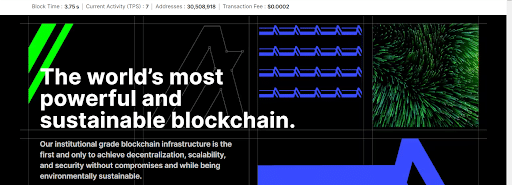The creation of crypto and NFT on Algorand is possible thanks to the ‘Algorand Standard Assets’ framework, which allows the network to compete with the numerous infrastructures on the market.
Let us take a look at the best crypto projects on Algorand, with a special focus on the presence of non-fungible tokens.
What is Algorand Crypto and what are the main NFT marketplaces?
Algorand is one of the most interesting Layer 1 blockchains in the industry, with a clear focus on scalability and environmental sustainability.
Algorand is a decentralised and open source blockchain, born in 2019 and founded by Italian Silvio Micali, a researcher and teacher at the prestigious Massachusetts Institute of Technology (MIT).
The main features of Algorand are the scalability of transactions, the energy sustainability of the blockchain and a particularly selective programming language.
Through a two-layer structure, Algorand is able to process many more transactions than Bitcoin and Ethereum, with a negligible commission cost of less than one cent.
The “Pure Proof-of-Stake” consensus algorithm provides an inclusive structure in which any holder of at least 1 ALGO can validate a block and receive a premium proportional to their allocation.
In terms of sustainability, one of the key pillars of the project is the “carbon neutrality” status that the blockchain enjoys.
At a time when the issue of Co2 emissions is a serious problem facing the globe, Algorand makes environmental friendliness one of the main vectors of its marketing campaigns, being much less polluting than bitcoin and its network of miners.
The TEAL programming language is very different from Solidity, Rust, Javascript and Cairdo, much more difficult to use and selective.
The complexity of programming smart contracts with TEAL is a limitation for the development of dapps in the ecosystem, but at the same time it allows greater security on the bug side, as it is more difficult to find flaws in the system.

As far as crypto and NFTs on Algorand are concerned, the first thing to say is that compared to Ethereum, Solana, Polygon and ImmutableX, the numbers on Silvio Micali’s blockchain are significantly lower, but potentially the technology has all the cards on the table to join the big boys in the sector.
Algorand’s main NFT marketplace platforms include Rand Gallery, ALGOxNFT, Exa Market, Shufl, Dartroom, Algogems, Abris, Aorist, Creecon and Republic.Many of these projects present solutions that are green for the environment and strengthen the power of content creators in the Web3 world.
Algorand crypto: some NFT data
Although Algorand is a very technical Layer 1 infrastructure specialising in transaction scalability, one of the most sought-after features in blockchain, it is not yet on par with other competitors when it comes to exchange volumes in the Non-Fungible Token market.
NFT cryptos on Algorand have not been appreciated by big investors and top performers, who prefer to mine their collections on Ethereum, the main venue for the creation of decentralised applications and smart contracts.
Consider that in April, according to CryptoSlam data, the volume of NFT sales on Algorand was around $350,000 compared to Ethereum’s $488,000,000, or more than 1,000 times less!
In total, since its inception, Algorand has seen volumes of around $38 million, while Ethereum has seen over $43 billion.
These figures clearly show that this type of activity on the decentralised network is still not appreciated by the masses, who prefer the traditional infrastructure for trading NFTs.
Recently, many users have even discovered that they can create non-fungible tokens on the bitcoin blockchain through digital artefacts derived from the inscription of individual satoshi, making them different from each other.
This has done nothing but shift the spotlight away from Algorand’s potential, at least in the NFT niche.

The best projects in the ecosystem
Beyond non-fungible tokens, the Algorand ecosystem has many different types of applications that are used every day by users in the Web3 world.
These include DEX, lending protocols, self-custody solutions, oracles and bridges, gaming applications and much more.
The expansion of the number of protocols on the chain is much more positive than the number of NFT cryptos sold on Algorand’s marketplaces.
In fact, when analysing the TVL, i.e. the total value locked in Algorand’s protocols, we can see that the project ranks in the top 20 with a figure of around $130 million.
Very interestingly, while the rest of the DeFi world lost value during 2022, Algorand bucked the trend and grew strongly in this respect, only suffering a sharp drop in TVL at the end of 2022, but partially recovering in Q1 2023.

Most of the liquidity is located on Algofi, a DeFi hub where classic decentralised financial transactions such as swaps, earning interest on stakes, borrowing assets, etc. can be executed.
Just after Algofi, which accounts for almost 68% of TVL, we find protocols such as Folks Finance, Lofty and Pact.
Lofty in particular seems very interesting, as it is one of the first prototypes of dapps that fractionalise real estate on the blockchain, through the process of tokenization of real assets.
Other notable projects built on Algorand include LimeWire, a decentralised social media platform, PeraWallet, a crypto-asset custody solution, and Dequency, a platform dedicated to developers.On the gaming front, the most popular applications with the largest followings on Algorand are The Drone Racing League, Zone and Algoseas.
 en.cryptonomist.ch
en.cryptonomist.ch